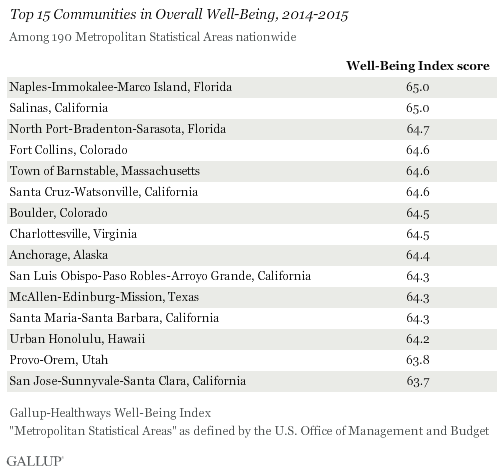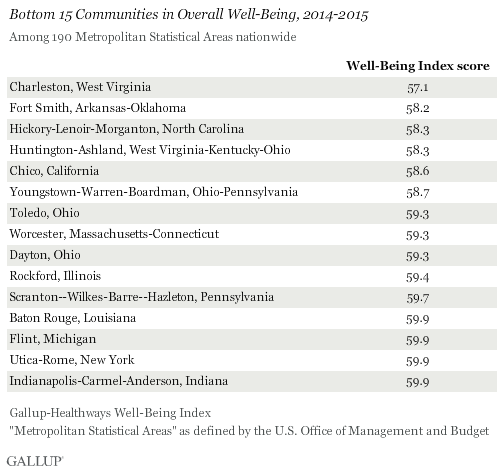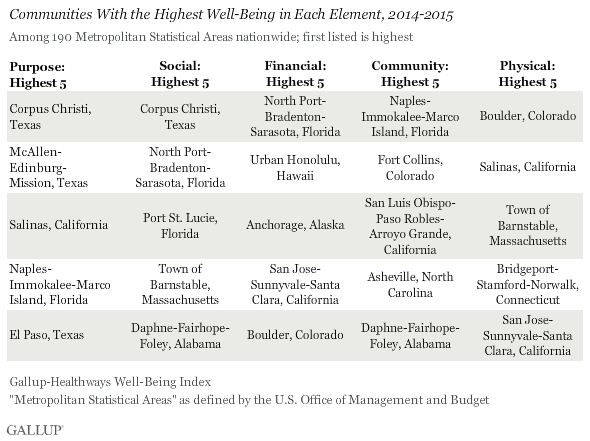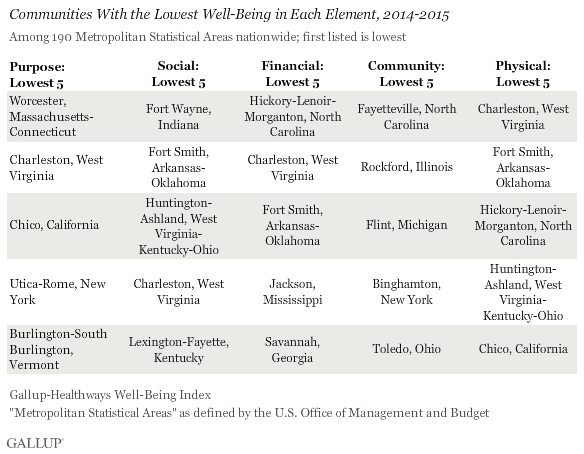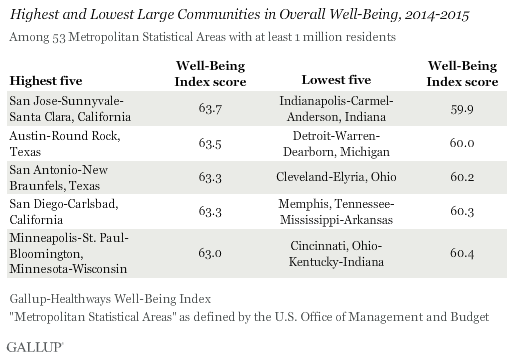Naples-Immokalee-Marco Island, Florida, No. 1 in Well-Being
Reposted with permission from Gallup
STORY HIGHLIGHTS
- Naples-Immokalee-Marco Island, Florida, up from No. 7 in 2012-2013
- Charleston, West Virginia, had the lowest well-being in 2014-2015
- San Jose-Sunnyvale-Santa Clara, California, topped all large metro areas
WASHINGTON, D.C. — Residents of Naples-Immokalee-Marco Island, Florida, had the highest well-being across 190 communities Gallup and Sharecare surveyed in 2014-2015, edging out Salinas, California. The remaining communities rounding out the top five were North Port-Bradenton-Sarasota, Florida; Fort Collins, Colorado; and the Town of Barnstable, Massachusetts.
Naples-Immokalee-Marco Island’s top ranking is an improvement from its No. 7 position in 2012-2013, and its Well-Being Index score in 2014-2015 slightly exceeded Salinas’ score when extended to two decimal points. Other communities that typically have ranked in the top 15 for well-being since 2008 include Boulder, Colorado; Honolulu, Hawaii; and Provo-Orem, Utah.
Charleston, West Virginia, earned the lowest well-being score in 2014-2015, with a number of Rust Belt communities accounting for most of the remaining lowest-ranked states. Many of the lowest well-being communities in 2014-2015 have consistently been among the lowest since 2008, including Charleston; Fort Smith, Arkansas-Oklahoma; Hickory-Lenoir-Morganton, North Carolina; Huntington-Ashland, West Virginia-Kentucky-Ohio; and Youngstown-Warren-Boardman, Ohio-Pennsylvania.
Baton Rouge, Louisiana, and Indianapolis-Carmel-Anderson, Indiana, had much higher rankings in prior years and appeared on the list of lowest well-being communities for the first time in 2014-2015.
These community-level data are based on more than 353,000 interviews with U.S. adults across all 50 states, conducted Jan. 2, 2014, through Dec. 30, 2015. The Gallup-Sharecare Well-Being Index is calculated on a scale of 0 to 100, where 0 represents the lowest possible well-being and 100 represents the highest possible well-being. The Well-Being Index scores for the nation and for each community are composed of metrics within each of the five essential elements of well-being:
- Purpose: liking what you do each day and being motivated to achieve your goals
- Social: having supportive relationships and love in your life
- Financial: managing your economic life to reduce stress and increase security
- Community: liking where you live, feeling safe and having pride in your community
- Physical: having good health and enough energy to get things done daily
In most cases, a difference of 1.0 to 2.0 points in the Well-Being Index score of any two communities represents a statistically significant gap, and is characterized by meaningfully large differences in at least some of the individual metrics that make up the Gallup-Sharecare Well-Being Index. The Well-Being Index for the U.S. in 2015 was 61.7, essentially unchanged from 61.6 in 2014.
Corpus Christi, Texas, Leads Communities in Purpose and Social Well-Being
Naples-Immokalee-Marco Island residents had the highest community well-being nationally, contributing to the community’s top well-being ranking overall. Corpus Christi, Texas, led the nation in both purpose and social well-being, but did not perform as well in the other three elements, resulting in an overall rank of 35th. North Port-Bradenton-Sarasota had the best financial well-being, while Boulder topped all communities in physical well-being.
Residents of Charleston had the lowest or second lowest well-being in three of the five elements: purpose, financial and physical. Similarly, Fort Smith was among the lowest three communities for social, financial and physical well-being. Flint, Michigan, which has suffered from a water purity crisis in recent months, was in the bottom three for community well-being, trailing only Fayetteville, North Carolina, and Rockford, Illinois. Flint has historically been among the lowest communities for overall well-being.
San Jose-Sunnyvale-Santa Clara Tops All Large Metros in Well-Being
San Jose-Sunnyvale-Santa Clara residents had the highest well-being among the nation’s 53 largest communities, those with at least 1 million residents. Austin-Round Rock, Texas, placed second among large communities. Both have commonly been among the top large metropolitan areas for overall well-being since measurement began in 2008.
Washington-Arlington-Alexandria, D.C.-Virginia-Maryland-West Virginia, historically one of the highest well-being cities in the U.S., had a lower score in 2014-2015 than in previous years, dropping to 8th among large communities and 38th overall nationally.
Detroit-Warren-Dearborn, Michigan, and Cleveland-Elyria, Ohio, join Indianapolis-Carmel-Anderson among the lowest three large communities.
Implications
U.S. communities are at the front lines of American well-being. City leaders are often able to create and sustain a culture of well-being in ways that leaders of more geographically diverse states cannot. This is critical, as well-being can have a very real effect on a wide variety of outcomes for a community. For example, communities with low well-being, as a whole, have residents with significantly higher obesity rates and double the heart attack incidence, thus incurring substantially higher healthcare costs. Conversely, communities with high well-being tend to have residents who learn and do interesting things daily, have safe places to exercise, have high energy levels and believe that their water is safe to drink.
One area that is critical to creating and maintaining high well-being in communities is jobs. Globally, individuals who report that now is a “good time” to find a job have substantially higher well-being than those who do not, and those who are employed full time for an employer evaluate their lives much better than others in the workforce do. In addition, being unemployed or involuntarily employed part time has been linked to depression, a common characteristic of individuals and communities with low well-being. The economic vibrancy of communities, in turn, reflects these broader relationships. San Jose-Sunnyvale-Santa Clara, for example, leads the nation in economic confidence, and seven of the top 10 large metros nationally in economic confidence are among the highest 12 large metro areas in well-being.
As community leaders think about strategies to improve residents’ lives, they should simultaneously consider the relationship between good jobs and well-being. Good jobs in a community boost the well-being of its residents, and residents with higher well-being attract potential employers seeking a workforce that has better job performance, less absenteeism and lower healthcare utilization.
Read the State of Community Well-Being report to see the full rankings.
SURVEY METHODS
Results are based on a subset of 353,983 telephone interviews with U.S. adults across all 50 states and the District of Columbia, conducted Jan. 2, 2014, through Dec. 30, 2015. In 2014, 176,702 interviews were conducted nationally; in 2015, 177,281 interviews were conducted. Gallup conducts 500 telephone interviews daily, resulting in a sample that projects to an estimated 95% of all U.S. adults. Metropolitan Statistical Areas (MSAs) are based on U.S. Office of Management and Budget definitions. Only MSAs with at least 300 completed interviews are reported, and results for each MSA are uniquely weighted according to Nielsen Claritas demographic targets.
The margin of sampling error for the reported communities ranges from ±1.7 points for the least populated to ±0.3 points for the most heavily populated. All reported margins of sampling error include computed design effects due to weighting.
For data collected prior to Sept. 1, 2015, each daily sample of national adults includes a minimum quota of 50% cellphone respondents and 50% landline respondents. For data collected between Sept. 1, 2015, and Dec. 30, 2015, each daily sample of national adults includes a minimum quota of 60% cellphone respondents and 40% landline respondents. Additional minimum quotas by time zone and within region are included in the sampling approach.
Learn more about how the Gallup-Sharecare Well-Being Index works.
